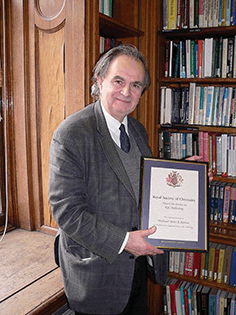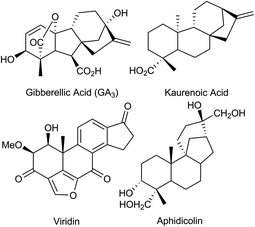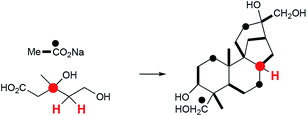Obituary: James (Jim) Ralph Hanson (1937–2018)†
J.
David Smith
 *a,
Thomas J.
Simpson
*a,
Thomas J.
Simpson
 *b and
Christine L.
Willis
*b and
Christine L.
Willis
 b
b
aDepartment of Chemistry, School of Life Sciences, University of Sussex, Brighton BN1 9QJ, UK. E-mail: j.d.smith@sussex.ac.uk
bSchool of Chemistry, University of Bristol, Bristol, BS8 1TS, UK. E-mail: tom.simpson@bristol.ac.uk
First published on 28th August 2019
Life and career
During the expansion of UK Higher Education after 1960 the role of a university teacher was often described as embracing teaching, research and administration. Jim Hanson made significant contributions, both to the University of Sussex and more widely to the chemistry community, in all three areas.He went to school in London during the Second World War and in later years often recalled what it felt like to go home not knowing whether the school would be there in the morning. He attended Queen Elizabeth’s Grammar School in Barnet from 1948 to 1955, apart from for most of 1950, when his family travelled to New Zealand as his father, a meteorologist, had a posting there. Jim inherited his father’s interest in the weather; sometimes when we thought he was thinking about organic chemistry he was looking at the clouds over the South Downs and working out when it would rain. At the end of his school career, Jim was one of very few people who gained five A-levels.
In 1995, he was awarded an open Stallybrass Memorial Exhibition at Brasenose College, Oxford. He graduated with a first class degree in chemistry in 1959 and obtained a post at the Imperial Chemical Industries, Akers Laboratory (The Frythe), where he worked on the gibberellins, a group of plant growth regulators. He left Akers in 1963 to complete a PhD degree with the Nobel Laureate Sir Derek Barton at Imperial College. Concurrently, during his final year, he taught in the evenings at St John Cass College, London. This experience gave him wide-ranging knowledge of organic chemistry and demonstrated the extraordinary stamina that he showed throughout his career.
He was appointed as a Lecturer at the University of Sussex in 1964, then promoted to Reader in 1973 and subsequently to Professor. He taught all the main course modules in organic chemistry and developed new ones for students majoring in medicinal chemistry, biochemistry and biology. In addition, he prepared and presented courses for visiting summer students, refresher courses for teachers, presentations for pre-university students, courses for workers in the pharmaceutical industry, and occasionally talks for members of the University of the Third Age.
His books on The Chemistry of Fungi (2008), Chemistry in the Garden (2007) and Chemistry in the Kitchen Garden (2015) enlightened experts and non-experts alike, giving everyone the opportunity to share his enthusiasm for chemistry and enjoy the wide-ranging examples of chemical processes that he found in everyday life. Other books, e.g. Some spectroscopic problems in practical organic chemistry (2017), were written to help teachers, both in schools and in higher education, make full use of the instrumental techniques that had been developed during his lifetime.
Jim also made a major contribution to university administration. He served on numerous academic committees and examination boards, and, for many years, was Sub-Dean of the School of Chemistry and Molecular Sciences. Before the appointment of specialist student welfare officers, the Sub-Dean dealt with students’ day-to-day academic, personal, administrative or bureaucratic problems. Many acknowledged Jim’s kindness, fairness, patience and encouragement.
Outside of the University, Jim was generous in the work he did for the Science and Engineering Research Council and the Royal Society of Chemistry. He served on the Downland Section Committee, as a national GRSC Assessor for practical organic chemistry, on the Journals Management Committee, and on several editorial boards, most notably for Natural Product Reports and The Journal of Chemical Research. He also undertook a punishing programme of reviewing for a range of other journals. He expected the highest standards of integrity. He was prepared to scrutinise in minute detail the experimental sections of submitted papers in order to detect carelessness or duplicity. Equally he was ready to help less experienced researchers and sometimes to offer alternative interpretations of their results.
For several decades, Jim was a member of the Applications Committee of the RSC and showed particular pleasure when people achieved Membership or Fellowship status after years of part-time study and work experience. He also served for many years as a meticulous External Examiner for the Chemical Society of Sri Lanka.
In comments made on his death two words stand out: “conscientious” and “unselfish”. He certainly worked hard. He drove 13 miles to the University each morning and was in the laboratory, library or his office, teaching, writing or reviewing manuscripts, from around 7 am to 6.30 pm. He did university work over weekends and did not take holidays. He disliked making speeches but was an excellent lecturer and good company in a small group. He was not a good self-publicist and sometimes allowed others to take credit for joint work. He gave no thought to getting a smarter car or a new jacket. His diffidence and care-worn appearance meant that he was sometimes undervalued, but he was one of the most resilient people. After a setback he would stubbornly carry on. One colleague who knew him well said: “I always thought Jim was somehow indestructible”.
In one of his last conversations, a week before he died, he was full of ideas about what the University or the Royal Society of Chemistry could do to make chemistry as a subject attractive to students. He had an encyclopaedic knowledge of organic chemistry but was always ready to learn more by attending seminars, discussing with colleagues what he had heard or read, and making suggestions for further research.
He also found time to encourage his children’s talent for music; he was delighted that his daughter and son became accomplished string players. Jim himself, encouraged by his school, was a pianist and cellist, and, for 46 years, an organist at St James Ashurst in West Sussex. He was knowledgeable about organs and organ music and frequently gave fundraising talks and recitals. As church warden (another time-consuming role), he was not only responsible for the fabric of the 12th century listed building, but also for the traditional liturgy of Morning Prayer. He studied the readings and Collects each week and, on Sundays when there was no priest to officiate, summarised them for the congregation.
He is survived by his wife Ann, daughter Karen, son Eric and grandchildren Melissa and Maryanne.
Research and scholarship
Jim Hanson’s scientific output was prodigious, comprising some 630 publications and reviews in addition to 13 books ranging from specialist monographs to general interest books on everyday chemistry. Over the four decades between 1970 and 2010, he published >100 papers each decade, with a staggering 175 in the 1989–1999 period (for a complete list please see the ESI†).The papers published in the 10 years from 1960 were almost exclusively on gibberellin plant growth regulators and related kaurenoid tetracyclic diterpenes from higher plants and fungi, an interest emanating from his time at the ICI Akers Laboratories and in which he maintained a lifelong interest. This was soon extended in Sussex to many other diterpenes, especially the anti-cancer and anti-viral metabolite aphidicolin from the fungus Cephalosporium aphidicola, and many fungal sesquiterpenes, e.g. botrydial and related compounds from the noble rot fungus Botrytis cinerea. His work centred on structure elucidation and biosynthesis, and he was a pioneer in the application of stereo- and regio-selectively labelled mevalonates to terpenoid biosynthesis, using both radio-labelled and 13C- and 2H- labelled precursors. Interestingly, this NMR-based work featured several collaborative efforts with his ex-school friend, Ian Sadler, in Edinburgh. Highlights of the period included his comprehensive labelling study on aphidicolin; a particular feature being the detection of a 1,2-hydride shift by incorporation of [3-13C, 4-2H2]mevalonate and observation of the resulting 2H–13C coupling and 2H-induced isotope shift of the corresponding 13C signal (Scheme 1).
The coupling pattern of the sesquiterpenoid, dihydrobotrydial, which was biosynthetically multiply labelled using [1-13C]acetate and included “induced 13C–13C-couplings”, was used to define the folding of farnesyl diphosphate during dihydrobotrydial biosynthesis (Scheme 2). He elucidated the structures of other fungal metabolites, particularly polyketide-derived pyrones, e.g. nectriapyrone from Gliocladium vermoesenii, and decanolides, and the cephalosporolides, also from Cephalosporium aphidicola.
From around 1970, his research interests in other areas of natural product chemistry increased. His other great area of output related to partial synthesis, rearrangements, aromatisations, and chemical and microbiological derivatisation of steroids, with the biotransformation work extending to other terpenoids and related model systems. He published many papers on the biosynthesis of highly oxygenated and degraded steroids of the viridin family from, inter alia, Gliocladium deliquescens.
Jim was without doubt the world-authority on terpenoids, as evidenced by the prodigious number of reviews on terpenoids he wrote and his prolific output on the partial synthesis of steroids which reflected his interest in the chemistry and rearrangements of complex polycyclic systems in general. He wrote annual reviews on diterpenoid chemistry from 1971 until 2018; these are regarded as the ultimate authoritative source for this family of natural products. The reviews first appeared in the Specialist Periodical Reports (SPR) series “Terpenoids and Steroids”, in addition to regular reviews on ‘The Biosynthesis of C5–C20 Terpenoid Compounds’ in the “Biosynthesis” series of SPR.
This logically brings us to his long-standing association with Natural Product Reports. In the early 1980’s, it became obvious that production of the SPR series covering different areas of natural products was becoming increasingly problematic. Jim, along with the other Senior Reporters of the ‘Terpenoids and Steroids’, ‘Biosynthesis’, ‘Alkaloids’ and ‘Aliphatics and related Natural Products’ series, formed a working party under the chairmanship of Gerry Pattenden to consider how best to proceed with the essential regular coverage of these areas that the SPR provided. The outcome was the creation of a conceptually new review-based journal, Natural Product Reports. Its remit was to continue the regular and comprehensive coverage provided by the SPR series, but to take advantage of the new format to introduce more occasional reviews of both general and specific interest to workers in the natural product and related fields. Jim was a founding member of the commissioning Editorial Board along with Derek Banthorpe, Michael Grundon, Frank Gunstone, Richard Herbert and Tom Simpson, with Gerry Pattenden as the first Chairman. In the next few years, new members included Don Whiting, John Mann, Chris Abell and Mike Page, all acknowledged leaders in UK natural products chemistry. Jim was by far the longest serving member of the Editorial Board, on which he remained for 23 years under various Chairmen, and subsequently acted as an Advisory Board member from 2007. In addition to his major responsibility of commissioning reviews in the general area of terpene chemistry, he was always characteristically energetic in proposing new initiatives. But he himself was also a prolific contributor, writing a total of 44 reviews, in addition to numerous book reviews and occasional obituaries. It is fair to say that without his dedication and efforts, Natural Product Reports may not have survived and developed into the successful journal that it has become.
His overall contributions to the RSC are alluded to above, and one has to mention the many educational articles that he wrote on teaching undergraduate chemistry and his many books covering natural products in general, isotopic labelling, steroids, tetracyclic diterpenes, biotransformations, functional group and protecting group chemistry, synthetic methods, applications of spectroscopic methods, and his “fun” chemistry, in addition to books on fungi, the chemistry of cooking, medicines and chemistry in the garden.
He was a polymath and a scholar, a traditional organic and natural product chemist to the core, and someone to whom the chemistry, reactions and properties of molecules were a continuing fascination. He was always very good if somewhat serious company, beyond teasing, as much as Gerry Pattenden tried in the early years of the Natural Product Reports Editorial Board! He was hugely productive and hard-working, and totally dedicated to his science. As well as an outstanding educator and scholar, Jim was extremely kind and generous, always supportive of students, colleagues and all those who had the good fortune to know him. His like will not be seen again.
Footnote |
| † Electronic supplementary information (ESI) available. See DOI: 10.1039/c9np90032b |
| This journal is © The Royal Society of Chemistry 2019 |




